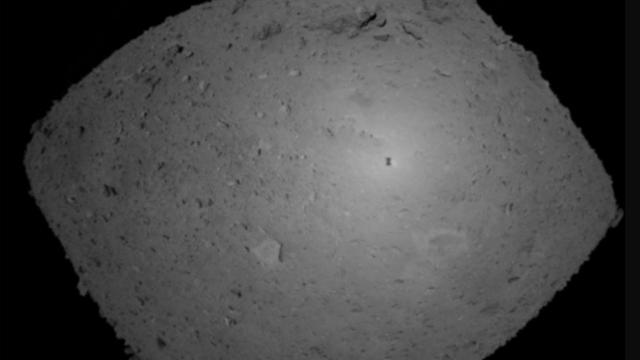Japan’s Hayabusa2 spacecraft has completed yet another intense mission: It used an explosive to blast a crater in the surface of the asteroid Ryugu. This success comes after the probe briefly touched down on the asteroid in February, firing a tantalum bullet into the surface in hopes of kicking up debris.
On Thursday, the Japan Aerospace Exploration Agency’s Hayabusa2 deployed its Small Carry-On Impactor Operation (SCI) to create an artificial crater that the probe will then be able to study. The JAXA team hopes this will allow them to observe how craters form in general on the asteroid.
This was a complex, multi-part experiment, and a process that in total boiled down to a critical window of about 40 minutes.
After deploying SCI and before detonation, Hayabusa2 had to reposition itself at a safe distance, out of the path of potential debris. According to the Planetary Society, this essentially involved scooting sideways before dipping downward so that it was situated somewhat behind Ryugu.
[SCI] The deployable camera, DCAM3, successfully photographed the ejector from when the SCI collided with Ryugu’s surface. This is the world’s first collision experiment with an asteroid! In the future, we will examine the crater formed and how the ejector dispersed. pic.twitter.com/eLm6ztM4VX
— HAYABUSA2@JAXA (@haya2e_jaxa) April 5, 2019
During the evacuation process, the spacecraft released its Deployable Camera 3 (DCAM3), which captured the action from about a kilometre away. As you can see in the tweeted image above, the SCI indeed kicked up debris after colliding with Ryugu.
The DCAM3 is equipped with two cameras, one high-resolution digital camera and one low-resolution analogue camera that should beam back images in real time.
Along with studying the aftermath of the artificial crater created by the impactor, Hayabusa2 might also be able to collect a sub-surface sample.
Ahead of Thursday’s blast attempt, scientists had a fairly rough estimate of how big a crater the explosive could produce. While some models put the width of the crater at around 10m, the target location for the impact had a 200m margin of error that accounted for different surface types, according to Planetary Society. We’re still waiting on updates from JAXA to learn more about the nature of the newly created crater.
Hayabusa2 rendezvoused with Ryugu in June 2018 following a four-year journey, and it has spent the last year carrying out all sorts of experiments.
In addition to deploying MINERVA-II rovers and the MASCOT lander, the spacecraft in February completed one of its biggest mission goals: Touching down on and firing a bullet into the asteroid’s surface, in hopes of kicking up debris that could be collected as samples and brought back to Earth.
We won’t know for sure whether the probe managed to snatch up samples until it returns to Earth in late 2020.
Hayabusa2 isn’t the only spacecraft currently studying a near-Earth asteroid. NASA’s OSIRIS-REx spacecraft is currently visiting the asteroid Bennu. If all goes according to plan, the NASA spacecraft will collect its own samples and bring them back to Earth in 2023.
